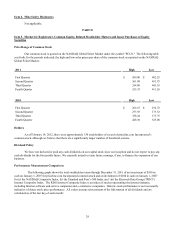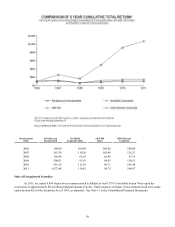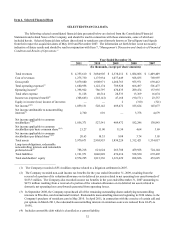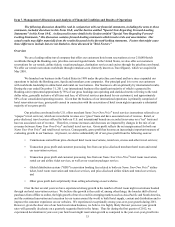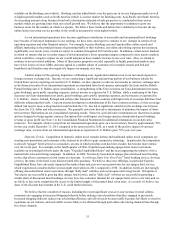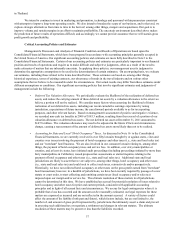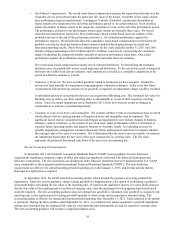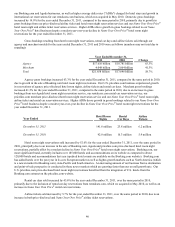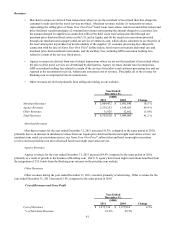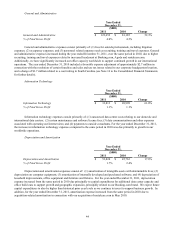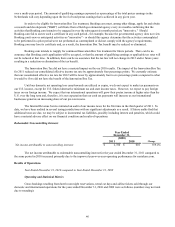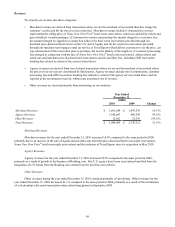Priceline 2011 Annual Report Download - page 39
Download and view the complete annual report
Please find page 39 of the 2011 Priceline annual report below. You can navigate through the pages in the report by either clicking on the pages listed below, or by using the keyword search tool below to find specific information within the annual report.38
• Stock-Based Compensation. We record stock-based compensation expense for equity-based awards over the
recipient's service period based upon the grant date fair value of the award. A number of our equity awards
have performance targets (a performance "contingency") which, if satisfied, can increase the number of
shares issued to the recipients at the end of the performance period or, in certain instances, if not satisfied,
reduce the number of shares issued to the recipients, sometimes to zero, at the end of the performance period.
The performance periods for our performance based equity awards are typically three years. We record
stock-based compensation expense for these performance-based awards based upon our estimate of the
probable outcome at the end of the performance period (i.e., the estimated performance against the
performance targets). We periodically adjust the cumulative stock-based compensation recorded when the
probable outcome for these performance-based awards is updated based upon changes in actual and
forecasted operating results. Stock-based compensation for the years ended December 31, 2011 and 2010
includes charges amounting to $10.3 million and $13.4 million, respectively, representing the cumulative
impact of adjusting the estimated probable outcome of unvested performance share units. Our actual
performance against the performance targets could differ materially from our estimates.
We record stock-based compensation expense net of estimated forfeitures. In determining the estimated
forfeiture rates, we periodically review actual and projected forfeitures. To the extent that actual or projected
forfeiture rates differ from current estimates, such amounts are recorded as a cumulative adjustment in the
period in which the estimate is revised.
• Valuation of Goodwill. We have recorded goodwill related to businesses we have acquired. Goodwill is
reviewed at least annually for impairment using appropriate valuation techniques. In the event that future
circumstances indicate that any portion of our goodwill is impaired, an impairment charge would be recorded.
A substantial amount of our goodwill relates to our acquisition of Booking.com. The estimated fair value for
Booking.com, as well as our other reporting units, is substantially in excess of their respective carrying
values. Since the annual impairment test in September 2011, there have been no events or changes in
circumstances to indicate a potential impairment.
• Valuation of Long-Lived Assets and Intangibles. We evaluate whether events or circumstances have occurred
which indicate that the carrying amounts of long-lived assets and intangibles may be impaired. The
significant factors that are considered that could trigger an impairment review include changes in business
strategies, market conditions, or the manner of use of an asset; under performance relative to historical or
expected future operating results; and negative industry or economic trends. In evaluating an asset for
possible impairment, management estimates that asset's future undiscounted cash flows to measure whether
the carrying value of the asset is recoverable. If it is determined that the asset is not recoverable, we measure
the impairment based upon the fair value of the asset compared to its carrying value. The fair value
represents the projected discounted cash flows of the asset over its remaining life.
Recent Accounting Pronouncements
In December 2011, the Financial Accounting Standards Board ("FASB") issued guidance for new disclosure
requirements regarding a company's rights of offset and related arrangements associated with financial instruments and
derivative instruments. The new disclosures are designed to make financial statements that were prepared under U.S. GAAP
more comparable to those prepared under International Financial Reporting Standards ("IFRS"). The new disclosure
requirements are effective for annual reporting periods beginning on or after January 1, 2013, and interim periods therein.
Retrospective application is required.
In September 2011, the FASB issued an accounting update, which amends the guidance on testing goodwill for
impairment. Under the revised guidance, entities testing goodwill for impairment have the option of performing a qualitative
assessment before calculating the fair value of the reporting unit. If, based on the qualitative factors, it is more-likely-than not
that the fair value of the reporting unit is less than its carrying value, then the unchanged two-step approach previously used
would be required. The new accounting guidance does not change how goodwill is calculated, how goodwill is assigned to the
reporting unit, or the requirements for testing goodwill annually or when events and circumstances warrant testing. The
accounting update is effective for annual and interim periods beginning after December 15, 2011. Early adoption of the update
is permitted. During the three months ended September 30, 2011, we performed our annual quantitative goodwill impairment
testing, and concluded that the estimated fair value for each reporting unit substantially exceeds its respective carrying value.
This new accounting guidance will not have a significant impact on us.



